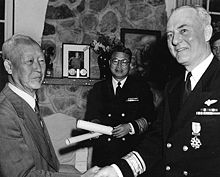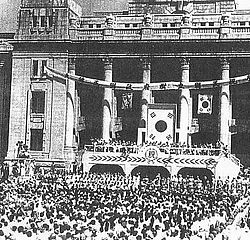- First Republic of South Korea
-
Republic of Korea
대한민국
大韓民國← 
←
1948–1960  →
→Anthem
애국가
AegukgaCapital Seoul Language(s) Korean Government Republic President I Seungman Vice President - 1948–1951 I Siyeong - 1951–1952 Gim Seongsu - 1952–1956 Ham Taeyeong - 1956–1960 Jang Myeon Legislature National Assembly History - Established 15 August 1948 - April Revolution 19 April 1960 Currency Won (1945–1953)
Hwan (1953–1962)First Republic of South Korea 
South Korean President Syngman Rhee bestowing a medal on a U.S. Navy Admiral.Korean name Hangul 제1공화국 Hanja 第一共和國 Revised Romanization Jeil Gonghwaguk McCune–Reischauer Cheil Konghwaguk The First Republic of South Korea was South Korea's first independent government, ruling the country from 1948 to 1960. It succeeded USAMGIK, the United States military government, which ruled the area from 1945 to 1948. The First Republic was established on August 15, 1948, with Syngman Rhee as the first president. Like subsequent governments, it claimed sovereignty over the entire Korean peninsula, although it only had power over the area south of the 38th parallel. The investiture of the Rhee government followed the general election of May 10, 1948. The country's first constitution had been promulgated by the first National Assembly on July 17. It established a system with a strong president, who was elected indirectly by the National Assembly.
Contents
Politics
Rhee was supported in the elections by the Korea Democratic Party, but didn't include any of its members in his cabinet. In retaliation, the members of the party formed a united opposition Democratic Nationalist Party, and began to advocate a cabinet system which would remove power from the president. This led to a regrouping of the Rhee faction into the Nationalist Party, which later became the Liberal Party, and remained Rhee's base throughout his administration. The country's second parliamentary elections were held on May 30, 1950, and gave the majority of seats to independents.
The nationalist government continued many of the practices of the U.S. military government. This included the brutal repression of leftist activity. The Rhee government continued the harsh military action against the Jeju uprising. It also crushed military uprisings in Suncheon and Yeosu, which were provoked by orders to sail to Jeju and participate in the crackdown. [1]
Prewar
This government also oversaw several massacres, the most notable being on the island of Jeju in response to an uprising by leftist factions.[citation needed]
Korean War
See also: Korean WarOn June 25, 1950, North Korean forces invaded South Korea (see Korean War). Led by the U.S., a 16-member coalition undertook the first collective action under U.N. Command (UNC). Oscillating battle lines inflicted a high number of civilian casualties and wrought immense destruction. With the People's Republic of China's entry on behalf of North Korea in 1951, the fighting came to a stalemate close to the original line of demarcation.
Armistice negotiations, initiated in July 1951, finally concluded on July 27, 1953 at Panmunjeom, now in the Demilitarized Zone (DMZ). The resulting Armistice Agreement was signed by the North Korean army, Chinese People's Volunteers and the U.S.-led and Republic of Korea-supported United Nations Command. A peace treaty has not been signed up to now. Following the armistice, the South Korean government returned to Seoul on the symbolic date of August 15, 1953.
Postwar events
After the armistice, South Korea experienced political turmoil under years of autocratic leadership of Syngman Rhee, which was ended by student revolt in 1960. Throughout his rule, Rhee sought to take additional steps to cement his control of government. These began in 1952 (shortly after being elected to a second term), when the government was still based in Busan due to the ongoing war. In May of that year, Rhee pushed through constitutional amendments which made the presidency a directly-elected position. In order to do this, he declared martial law and jailed the members of parliament whom he expected to vote against it. Rhee was subsequently elected by a wide margin. He regained control of parliament in the 1954 elections, and thereupon pushed through an amendment to exempt himself from the eight-year term limit.
Rhee's prospects for reelection during the presidential campaign of 1956 initially seemed dim. Public disillusionment regarding his attempt to seek a third term was growing, and the main opposition candidate Shin Ik-hee drew immense crowds during his campaign. Shin's sudden death while on the campaign trail, however, allowed Rhee to win the presidency with ease. The runner-up of that election, Cho Bong-am of the Progressive Party, was later charged with espionage and executed in 1959.
The events of 1960, known as the April Revolution, were touched off by the violent repression of a student demonstration in Masan on the day of the presidential election, March 15. Initially these protests were quelled by local police, but they broke out again after the body of a student was found floating in the harbor. Subsequently nonviolent protests spread to Seoul and throughout the country, and Rhee resigned on April 26.
Education
This period saw explosive growth in education at all levels, even during the turmoil of the Korean War. The First Republic saw the full implementation of an educational system that had been sketched out by the Council for Korean Education under USAMGIK. This education was shaped by the ideal of Hongik Ingan, the person who is a benefit to all, and sought to prepare students for participation in a democratic society. Some contend that this democratic education contributed to the student protests which brought down the authoritarian Rhee government in 1960.[2]
The first Education Law came into force on December 31, 1949. [3] The most important aspect of this was the introduction of universal compulsory education at the primary level. This requirement led to widespread school construction; by the end of the First Republic, primary-school enrollment had topped 95%. In addition, the dual ladder system used by the Japanese occupation government was replaced by a single-ladder system, with 6 years of primary education, 3 of middle-school education, 3 of high-school education, and 4 of college education.
This period also saw the adoption of South Korea's first national curriculum.
Economy
The economy of this period was deeply troubled.
In 1945–1950, United States and South Korean authorities carried out a land reform that retained the institution of private property. They confiscated and redistributed all land held by the Japanese colonial government, Japanese companies, and individual Japanese colonists. The Korean government carried out a reform whereby Koreans with large landholdings were obliged to divest most of their land. A new class of independent, family proprietors was created.
International relations
Rhee sought to align his government strongly with the United States, and against both North Korea and Japan.[4] The policy of the First Republic on North Korea, before and after the Korean War, was one of "unification by force." [5] Although some talks towards normalization of relations with Japan took place, they achieved little.[6] Meanwhile, the government took in vast sums of American aid, in amounts sometimes near the total size of the national budget.[7]
On January 18, 1952, Rhee declared South Korean sovereignty over the waters around the Korean peninsula, in a concept similar to that of today's exclusive economic zones. The maritime demarcation thus drawn up, which Rhee called the "Peace Line", included Liancourt Rocks as South Korean territory.
Notes
- ^ Cumings (1997, p. 221).
- ^ Yang (1999, p. 756).
- ^ Yang (1999, p. 755).
- ^ Yang (1999, pp. 194–195).
- ^ Yang (1999, p. 193).
- ^ Yang (1999, p. 194).
- ^ Cumings (1997, p. 255, p. 306).
References
- Cumings, Bruce (1997). Korea's place in the sun. New York: W.W. Norton. ISBN 0-393-31681-5.
- Lee, Ki-baek, tr. by E.W. Wagner & E.J. Shultz (1984). A new history of Korea (rev. ed.). Seoul: Ilchogak. ISBN 89-337-0204-0.
- Nahm, Andrew C. (1996). Korea: A history of the Korean people (2nd ed.). Seoul: Hollym. ISBN 1-56591-070-2.
- Yang, Sung Chul (1999). The North and South Korean political systems: A comparative analysis (rev. ed.). Seoul: Hollym. ISBN 1-56591-105-9.
- Yonhap News Agency (2004). Korea Annual 2004. Seoul: Author. ISBN 89-7433-070-9.
See also
History of South Korea Categories:- Former republics
- Former countries in East Asia
- States and territories established in 1948
- States and territories disestablished in 1960
- History of South Korea
- 20th century in South Korea
Wikimedia Foundation. 2010.


